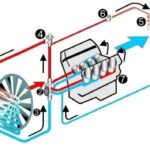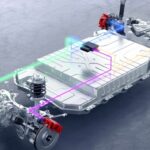Slide 1. Introduction.
The class develops whether it is safe to drive an electric vehicle in heavy rain and storms, and the implications for fleet management.
Slide 2. Driving an electric vehicle in floods and heavy storms.
- The dangers of driving through large amounts of water.
The real danger when crossing water comes from the dynamics and height. If the depth exceeds certain thresholds, the car can partially float and lose steering. Motorist organizations and clubs recommend avoiding driving through deep water. As a reference, it is not recommended to drive through water deeper than 10 centimeters with conventional passenger cars and a greater height for SUVs. This is a conservative guideline that also applies to electric vehicles, unless there is an official published fording depth.
If there is no choice but to cross, it is recommended to do so very slowly and in a straight line, avoiding waves and sudden acceleration. It is not advisable to drive behind trucks that generate waves, and if you are unsure of the depth, do not enter. After crossing, brake gently for a few meters to dry the discs and check the dashboard alerts. Drive smoothly, keep a safe distance, and pay extreme attention to puddles, as they can destabilize the vehicle.
If you are caught in a flood, turn around if you can. Never trust the apparent depth, avoid currents, and remember that the greatest danger is becoming immobilized. If your vehicle stalls or stops in deep water, evacuate safely and call for roadside assistance. Do not attempt to start or charge the car after submersion until it has been inspected by a technician.
- Electric vehicle protection.
At the regulatory level, electric vehicles sold in Europe must comply with UNECE R100 Rev. 3, which establishes the electrical safety requirements for high-voltage systems, as well as watertightness and insulation tests. In addition, ISO 6469-3 establishes protective measures against electric shocks or thermal incidents. This framework explains why there is no risk of electrocution for occupants under normal conditions, such as rain, shallow puddles, or automatic car washes.
There is no danger to occupants from a flooded high-voltage battery: as soon as the car detects a deviation in the insulation resistance of the high-voltage system, the battery is disconnected and the entire system is shut down.
- Real risk of water entering the motor of an electric car.
Exposure to flooding or deep puddles can affect sensitive components such as the electrical system, battery, and control electronics.
Modern electric cars rely on a number of complex electronic systems. Water ingress into the motor can cause starting failures, as well as problems with power management, battery charging, and overall vehicle safety.
The combination of water and electrical components does not usually end well. Even with sealed batteries, electric cars have connections and circuits that are exposed to moisture if the vehicle is submerged. Water currents carry sediment and salts that accelerate corrosion.
The motor of an electric car is not designed to cross rivers or areas where the water level exceeds the bottom of the chassis. Attempting to start it after flooding can cause short circuits or damage to the ECU. If the car has been affected by flooding with the motor off, it is essential not to attempt to start it.
It is essential to carry out a complete check of the electric car after water has entered the engine. Checking the seals, connections, and electronic systems ensures that the vehicle is working properly. Prevention and timely maintenance prevent major problems and extend the life of the vehicle.
- Can an electric car be charged in the rain.
In this case, it is also safe to charge an electric car in the rain, provided that approved equipment in good condition, designed for this purpose, is used. Never attempt to charge the car if the charging point or connector has been submerged or shows visible damage. Tesla itself, in its “submerged vehicle” guide, advises against handling or charging a car that has been submerged and recommends following specific procedures.
- The Faraday cage: Your car protects you from lightning.
Cars are designed so that lightning strikes the exterior of the bodywork without causing any harm to the occupants, as they act as a Faraday cage, canceling out the electric field inside the vehicle. This happens in both electric and combustion cars, provided they have a hard top rather than a convertible roof. Therefore, staying inside a vehicle can be a good option during a thunderstorm.
After a possible lightning strike, avoid touching the metal parts of the vehicle, as they may still contain much of the electricity from the lightning. Once on the ground, walk slowly and take very short steps to avoid an electric shock.
The lightning may affect some of the vehicle's systems due to the overload received. This is a possibility that can affect any type of vehicle, regardless of its power source.
If lightning strikes the vehicle, keeping the windows up can also help minimize its effect.
- 10 essential tips for driving in heavy rain or storms.
1. Recharge the vehicle before setting off.
Always try to set off with a fully charged battery to avoid running out of power in a critical situation.
2. Check the tires.
Make sure your tires are in good condition; the deeper the tread, the better. The pressure must also be correct; check the manual for the recommended pressure for your vehicle. Remember that tires in good condition improve traction and reduce the risk of skidding.
3. Drive at a safe speed.
In heavy rain, road grip is reduced by up to 50%. Therefore, driving at a moderate speed will help you maintain control of the vehicle.
4. Increase your safety distance.
Braking distance increases by 20-30% when the road is very wet.
5. Drive smoothly.
Avoid sudden braking and turning, as this can cause you to lose control of the vehicle.
6. Drive in the tracks of other vehicles.
The tracks of other vehicles tend to have less water accumulated in them. Driving in them can reduce the risk of hydroplaning.
7. Keep your windshield as clear as possible.
Visibility is reduced in heavy rain, hail, or storms, making driving difficult. Make sure your windshield wipers are in good condition and keep your windows clear of fog.
8. Avoid flooded areas and deep puddles.
For your own safety and that of your passengers, never drive through flooded areas. Your vehicle could be swept away, with fatal consequences. Deep puddles can damage the underside of the vehicle and even some electrical components, despite the protections provided for sensitive parts.
9. Always drive with your lights on.
Drive with your lights on to increase your visibility. This will also make your vehicle more visible to other drivers and minimize the risk of collisions.
10. Reduce the use of electrical accessories.
Limit their use during heavy rain or storms to conserve battery power and reduce the risk of electrical problems in critical situations.
- Implications for fleet management.
The main consequence is breakdowns that can occur due to exposure to flooding or deep puddles, with the cost and downtime that the vehicle is out of service.
- Develop an action protocol.
An action protocol for torrential storms and flooding must be developed and printed in the vehicle.
- Vehicle use.
In the event of flooding or deep puddles, it is recommended not to use electric vehicles, except in emergencies or if the vehicle's wading height allows it.
If we encounter flooding or a very deep puddle on our route, it is recommended to avoid it and find a new route back to our vehicle parking lot.
If there is no alternative, it is recommended to stop and park the vehicle in the highest area possible.
If our vehicle parking lot is going to flood, it is recommended to park the vehicles in the highest area possible and disconnect the chargers from the power supply.
It is recommended to identify these geographical areas where vehicles can be parked in the event of a risk of flooding of our vehicle parking lot and to include them in the action protocol.
- Vehicle parking.
There are geographical areas that suffer from flooding, typhoons, or torrential rains at certain times of the year. It is recommended that vehicle parking facilities have at least one upper level above ground level for parking vehicles in the event of flooding.
- Consult the vehicle manual.
Consult the manufacturer's manual to find out the ground clearance and maximum wading depth allowed for each specific model and include this in the action protocol.
- Driver training.
Drivers must receive training on the action protocol and how to drive in floods and torrential rain.
- Electric vehicle inspection.
If the electric vehicle has been through floods or deep puddles, the connections, battery, and electric motor must be inspected afterwards for any damage or faults.
- Vehicle purchase.
When purchasing an electric vehicle, it is important to consider protection and insulation in case of flooding or deep puddles.
Vehicles should be purchased that have the appropriate safety measures and protections, and that comply with UNECE R100 Rev.3 regulations as well as ISO 6469-3.
In summary, an electric car can drive in the rain and through puddles or shallow water normally thanks to its design and safety regulations. However, it is not advisable to drive through large pools of water or moving water, let alone salt water after storms. Drive gently, avoid unknown depths, respect the wading depth, and do not tamper with or load a vehicle that has been submerged. This will minimize the risks to people and the vehicle itself.
Slide 3. Thank you for your time.
The class has developed whether it is safe to drive an electric vehicle in heavy rain and storms, and the implications for fleet management, see you soon.
Download the audio




















